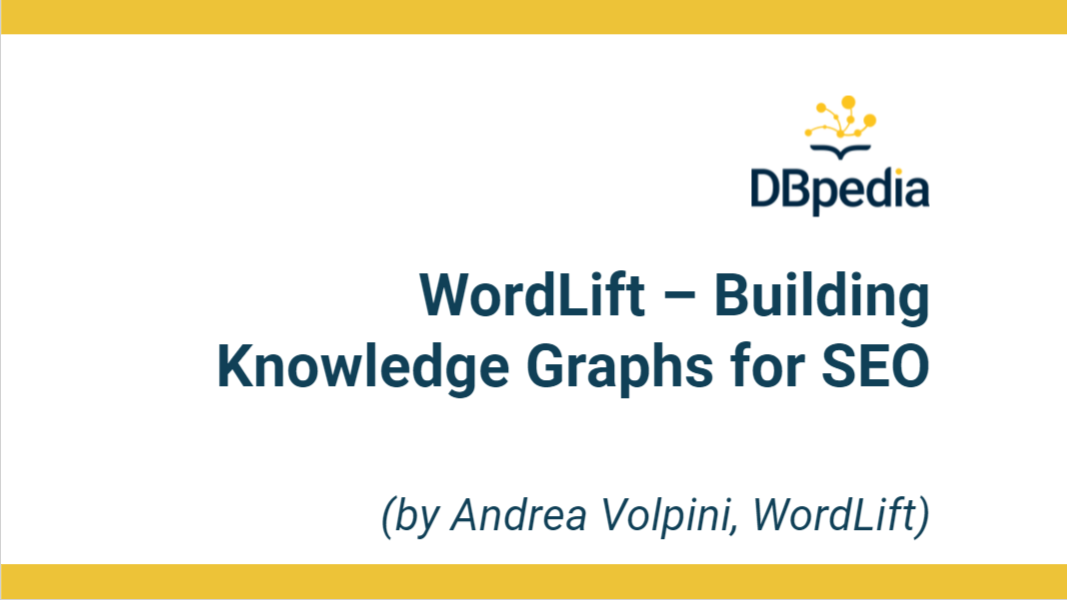DBpedia Member Features – Over the last year we gave our DBpedia members multiple chances to present their work, tools and applications. In this way, our members gave exclusive insights on the DBpedia blog. This time we will continue with WordLift. They will show us how they help companies speak Google’s native language with data from DBpedia. Have fun while reading!
by Andrea Volpini, WordLift
WordLift is a Software as a Service designed to help companies speak Google’s native language by converting unstructured content into structured data that search engines understand.
It does so automatically, using natural language processing and machine learning. Most SEO tools provide insights on improving a website. WordLift creates a knowledge graph and automates some of these SEO tasks to help a site rank. We call it agentive SEO: from search intent analysis to content generation, from building internal links to improving on-page user engagement. At the core of this automation, WordLift creates 5-stars linked data using DBpedia.
Artificial Intelligence is shaping the online world. Commercial search engines like Google and Bing have changed dramatically in the last two decades: from 10 blue links to algorithms that answer user questions without ever clicking a link or leaving the results page. As search evolves, so do the SEO tools that marketers need to cope with these changes.
Why creating a Knowledge Graph improves SEO?
Imagine the knowledge graph behind a website as the most thoughtful way to help crawlers index and understand its content. Much like Google uses the graph as the engine to power up its search results, a knowledge graph that describes a website’s content helps machines understand the semantic meanings behind it.
In practical terms, a customised knowledge graph helps content marketers in different ways:
- Enhancing SERP results with structured data and helping Google and Bing disambiguate your brand name or services adequately.
- Automating internal links to increase rankings around entities that matter for the business.
- Providing content recommendations to enhance the customer journey.
- Bringing additional insights to web analytics by grouping traffic related to entities and not only pages (i.e. how is the content on “artificial intelligence” performing this week?).
- Providing the factual data required for training language models that can automatically generate content (you can read all about it in my latest blog post on AI text generation for SEO, where you will have the code to fine-tune Google’s T5 using triples from DBpedia 🎉)
Here is an example of Natural Language Generation using Google’s T5
Search Intent Discovery: a practical example of how marketers can use a KG
Let me give you another example: keyword research. The purpose of keyword research is to find and analyze search queries that people enter into search engines to create new content or improve existing ones. Using the custom knowledge graphs that WordLift produces, we help our clients quickly scout for new untapped search opportunities.
The chart above shows a series of search intents (queries) that WordLift has generated after the user provided three ideas. Using the knowledge graph, these intents are grouped into topics such as “Android”, “Anonymity” or “Gamer” and the content editor can find the right query to target. In the treemap chart, larger boxes correspond to a higher search volume, and lighter colors indicate less competitive queries.
How does WordLift build a Knowledge Graph?
An entity represents the “thing” described in web pages. Entities help computers understand everything about a person, an organization or a place mentioned on a website. Each entity holds the information required to provide direct answers to questions about itself and questions that can be answered by looking at the relationships with other entities. WordLift uses natural language processing to extract and connect entities with web pages. Therfore we primarily use schema.org vocabulary to build its knowledge graphs.
WordLift heavily relies on DBpedia. We train our content analysis API on concepts that are in DBpedia and we build knowledge graphs that interlink, among other graphs, with DBpedia.
We are also starting to automatically create content using language models trained with data from DBpedia. More on this front will come in the next future.
WordLift and the open DBpedia Knowledge Graph
Our users constantly publish and update public web data from various sources (their websites, the catalogue of their products, a data feed from a partner and more) and interlink the entities they publish with DBpedia.
We are now excited to contribute back some of this knowledge. With the help of DBpedia we can keep on building a distributed, queryable and decentralized linked data cloud.
Keep following us and keep contributing to the LOD cloud!
A big thank you to WordLift. Especially Andrea Volpini for presenting how WordLift creates a KG and automates some SEO tasks helping a site rank.
Yours,
DBpedia Association
- Did you consider this information as helpful?
- Yep!Not quite ...

